Optimizing Equipment Performance with Industrial Filters and Separators
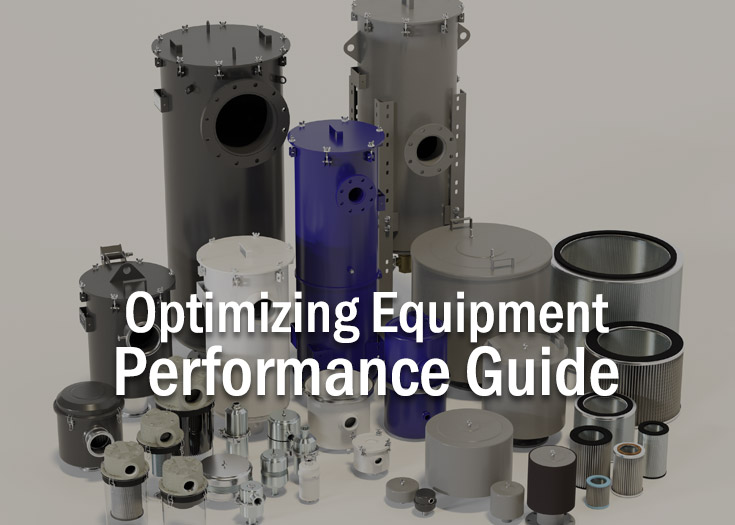
Introduction:
Industrial filters are critical system components for many manufacturing processes and applications. Protecting equipment with the proper filtration is crucial for any companies that are operating vacuum pumps, blowers, compressors, fans, and other pneumatic air moving equipment within their facilities.
The process of air filtration dates back centuries. One early example of a filter used to purify air can be seen in the bird beak mask of the Plague doctor costume worn by plague doctors during the 1600s.
At the time, the theory was that breathing putrid air caused the infection. As such, plague doctors would fill the beak with herbs and other items to mask the odors. The mask, with its extended housing packed with plant materials and other fibers, acted as a crude filter to protect the wearer.
The putrid air theory suggested that the plague would become airborne when a person coughed or sneezed. Turns out the plague doctors were on to something as the pneumonic plague was transmitted through the air. Perhaps the bird's beak mask provided just enough filtration protection to keep the plague doctors from becoming infected by it.
Beginning in the 1800s, the enormous potential of compressed air to power tools in mining applications and other industrial processes was realized as technology became more advanced.
Fast forward to today: air-end technologies have evolved and internal tolerances for the rotating parts are much tighter. One of the key uses of filtration is protecting equipment from ingesting harmful particles, which is necessary for optimal equipment performance and longevity.
Over the last fifty years, this need has driven significant advancements with industrial filtration. New air filter media technologies and material manufacturing methods allow for high-efficiency filtration designs that help optimize equipment performance in the most severe operating conditions.
In this article, we will address some of the most common questions regarding industrial filtration, including how industrial filters work, what are the different types of filters, and how to select the right filter for specific applications.
What are Industrial Filters and Why Do You Need a Filter?
In the simplest of terms, an industrial filter is a device that removes particles from an air stream. This is done with a specialized housing and filter element. Housings are commonly constructed of metals or plastics and offer a broad range of connection sizes and styles.
Filter elements are typically made of:
- Polyester filter media
- Paper filter
- Foam filter material
- Fiberglass filter media
- Metal mesh filter material
- Other suitable porous media
Filter elements can also contain purifying absorptive materials like activated carbon, activated alumina, and molecular sieve.
The filtration system requires airflow to move the particles through the filter housing and element. Sources of airflow can include vacuum pumps, blowers, fans, compressors, engines, or turbines. Particles are captured and stored for safe removal within the element. Many housings have containment holding sections that can hold large amounts of powders, liquids, and other captured materials.
Filters are used for numerous industrial applications, particularly in manufacturing. Here are some of the most common uses for industrial filters:
Protecting Equipment from Ingesting Harmful Contaminants
One of the core purposes of industrial filter systems is to protect manufacturing equipment. Oftentimes, particles are released during the manufacturing process which can accumulate within the machinery. Over time, this could clog up vents or gears. In turn, this can cause the machinery to overheat or become damaged.
Industrial filters are designed to capture airborne particles, aerosols, and vapors so they can be safely removed without damaging any equipment. As a result, this extends the life of the machinery.
Removing Contaminants to Purify Air and Gas Streams
Airborne particles may also need to be filtered from the air or gas to ensure purity. This helps to remove small contaminants such as dust particles or powdered substances. This is often crucial in manufacturing applications like additive manufacturing, landfill gas collection, and plastic production.
Protecting the Work Environment
Emissions from the manufacturing process can create safety hazards in the workplace. For instance, oil mist may condense on the floor, creating slippery surfaces. Dust may also accumulate on the equipment, making the workplace appear less sanitary.
Industrial filter systems help to eliminate the number of particles that escape from the manufacturing equipment, supporting a safer and cleaner workplace.
Separating and Isolating Desirable Product from the Air Stream
Specialized industrial filter systems can be used to remove, separate, and isolate specific elements from air streams. This is important in pharmaceutical or chemical production, as certain products need to be extracted. In this case, a specialized industrial filtration system is typically required to isolate specific fluids, solids, or vapors.
The Filtration Process for Air and Gas
The definition of industrial filtration is the process of removing suspended particles from a fluid, gas, or air stream by utilizing a flow through a permeable or porous medium. To achieve flow through the media, a pressure difference is needed to push or pull air through the media.
Several factors are considered when evaluating requirements for air/gas and industrial filtration applications:
Gas and air filtration require a permeable or porous medium within the filter. This media must have openings to allow a consistent flow while limiting the number of particles that can pass through the filter.
Numerous types of filtration media are used, depending on the application and purpose. Generally, most industrial filters are made of paper or polyester filter media. These materials are used due to their commercial availability and broad compatibility with general applications.
Other filter media include:
Micron Size
The unit of measurement for industrial filters is referred to as the micron size. Particles are measured in micrometers (μm) which is 0.00004 inches in length. So, a filter with a smaller micron rating can filter out smaller particles. For example, a 2 micron rating will remove particles that are smaller in size than a filter with a 5 micron rating.
Particles like some bacteria, viruses, and smoke are extremely small, whereas dust is generally larger. Specialized filters can be used to filter out specific types of contaminants based on their size.
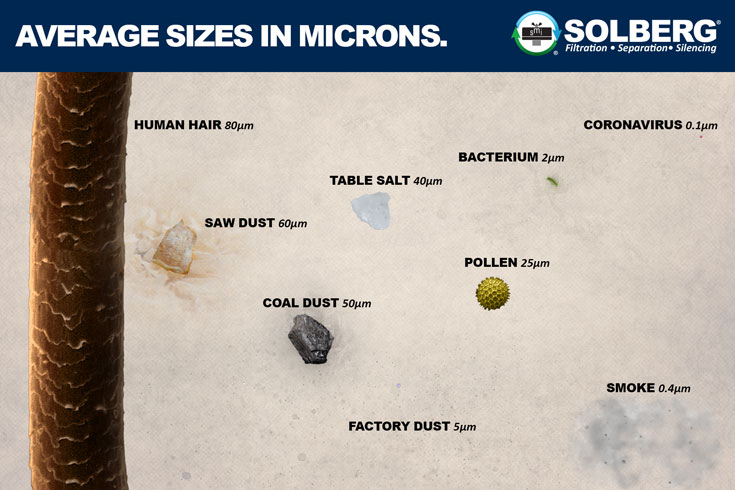
Efficiency
The level of filtration is indicated with an efficiency rating as a percentage. The rating indicates a filter’s ability to remove specific-sized particles from the air stream. It is expressed along with the micron rating, such as “95% removal efficiency rating at 10 microns.”
An efficiency rating of 99% at 5 microns is suitable for most industrial applications. Many industries require finer particulate and specify HEPA efficiency ratings of 99.97% at 0.3 microns or better. Generally, high-quality filters will have an efficiency rating of 99% or better.
Dust Loading of a Filter
Dust loading is the process by which a filter captures a contaminant over time. The dust loading rate is a measurement of how much of a specific contaminant (such as dust or other particulates) a filter can capture before it becomes less effective.
Dust loading is dependent on numerous factors, such as the number of particles in the gas/air stream at any given time and the effective surface of the filter element. As these particles build up within the filter, they will compromise its effectiveness. This may also negatively impact equipment performance as the pressure differential across the element rises.
It is important to note the dust loading characteristics of a filter over time for a specific installation. By noting the date the filter is installed and the change-out date, approximate expected filter life for the installation can be determined and a maintenance schedule can be developed.
Pressure Differential
The pressure differential indicates the resistance to airflow across a filter media or through different components of the filtration system. This is the difference between the pressure on the upstream side versus the downstream side of the filter media.
Mechanisms of Filtration
There are various mechanisms involved in air filtration containment removal. The most common mechanisms for industrial filtration are outlined below.
Impaction
Impaction filtration (also called Inertial Impaction) relies on the momentum of a particle in an airstream to deviate from the airflow path and impact the filter media. The particle's velocity and inertia cause it to travel in a continuous direction until it impacts the filter media. Impaction is typically in effect for heavier particles with sizes greater than 1 micron.
Interception
Interception filtration relies on the media to intercept particles in an airstream that follow the airflow path without deviation. The fibers in the filter media will “catch” the particles so they cannot move through the filter. Interception is typically seen with particle sizes greater than 0.1 microns.
Diffusion
In diffusion, the motion of the contaminants is random – also known as Brownian motion. This makes it more difficult to capture since it does not follow the straight pattern of the airflow. So, a higher concentration of fibers is needed to create more surface area for the particulates to be attached to it. Diffusion is typically in effect for particle sizes smaller than 0.1 micron and lower airflow velocities.
Solberg’s industrial filters operate using impaction and interception for contaminants that measure 1 micron or larger. However, there are specialty filtration products such as HEPA and ULPA filters that are rated for 0.3 to 0.1 micron filtration.
Types of Industrial Filters and the Problems They Solve
Numerous types of industrial filters are designed for specific applications, equipment, and purposes. Different designs are made of varying mediums such as paper, polyester, or fiberglass, depending on the pore size needed in the filter.
Additional important criteria to consider are the flow rate and pressure drop. Any flow’s stream pressure will drop as it enters a filtration system. The smaller the filter pore size and the more restrictive it is, the more pressure it will create which will restrict the air or gas flow.
Each type of filter is designed for specific use within an industrial process. For instance, some are used at the inlet of vacuum pump systems to protect the pump from processes that give off harmful particulates. These are used for inline filtration in vacuum pump systems to protect equipment by filtering abrasive or damaging particles. Some are used on the exhaust side of vacuum pumps to filter the discharge air before being emitted into the atmosphere.
Let’s discuss eight of the common types of filters along with features that they may include for various applications:
1. Particulate Filters
What are Particulate Filters?
Particulate removal filters use different filter media to capture specific micron sizes of contaminants. Some can even be designed for bacterial filtration, others for chemical adsorption.
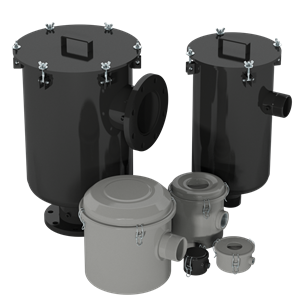
Particulates refer to small particles which can enter the air or gas stream during certain processes. For instance, in pharmaceutical manufacturing, dust may be present from mixing ingredients or in a pneumatic conveying process and accumulate within the air stream. This must be removed so that it does not contaminate the product or build-up within the equipment.
Problems Particulate Filters Solve
Particulate removal filtration helps keep abrasive particles out of equipment and also keeps lubricating and seal oils clean. In both cases, the filter helps facilitate a long and productive life for the equipment. In other cases, such as powder packaging and loading, the filter serves as a breather to allow displaced air to vent from the container being filled.
As the air is vented, any dust particulate in the air stream is captured allowing clean air to escape into the surrounding area. Particulate filtration can help to protect both internal components of equipment and external environments clean and free from contaminants such as dust.
Common Applications and Equipment for Particulate Filters
Particulate removal filters are commonly used in the following applications:
| Vacuum Packaging |
Vacuum Lifting |
Factory Automation |
| Woodworking |
Ash Handling |
Cement Processing Conveying |
| Glass or Ceramic Vacuum Systems |
Glass Bottle Manufacturing |
Pulp and Paper Processing |
|
Pneumatic Conveying Systems
|
Laboratory Industries
|
Hospital Vacuum Systems
|
| Medical Gas Distribution |
Power Generation |
Biodiesel |
| Food and Agriculture |
Food Processing |
Chemical and Petrochemical Production |
| Plastic Forming and Extrusion |
Commercial Printing |
Electronics |
| Wastewater |
Tank and Reservoir Breathers and Vents |
Solar Energy |
| CNC Hold Down and Router Table |
Glass Manufacturing |
Vacuum Trucks |
| Transformer Manufacturing |
Essential Oils |
Metallurgy and Vacuum Furnace |
| Fuel Cell |
Laboratory and Testing Facilities |
Marine and Workboat Applications |
| Compressor Inlet |
Oil Flooded and Dry Vacuum Pumps |
Radical and Centrifugal Fan |
| Lithium-Ion Battery Manufacturing |
|
|
2. Liquid Removal
What are Liquid Removal Filters and Separators?
Liquid removal filters and separators, sometimes referred to as liquid knockout pots or condensation traps, help to remove liquids in the form of slugs, slurries, droplets, and mists from the process air stream. Liquid removal separators can protect equipment in both vacuum and pressure applications. Some liquid filters feature see-through housings for visual inspections and additional safety features to auto-drain or stop airflow to the equipment in catastrophic situations.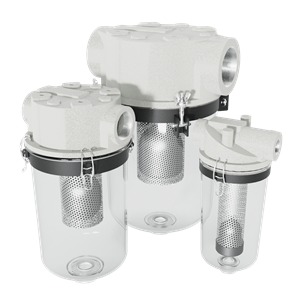
Problems Liquid Removal Filters Solve
Liquid removal filters and separators capture liquids present in the air stream and keep potentially dangerous or contaminated liquid from entering equipment and causing damage. Because liquids are not compressible, they can do great damage to the internals of vacuum pumps and compressors when ingested.
In many applications where humidity levels and air saturation levels are high such as food processing and biogas production, liquids will condense in piping and migrate in the direction of airflow towards the equipment. Liquid removal systems capture and hold liquids until they can be safely removed.
Common Applications and Equipment for Liquid Removal Filters
Liquid removal and mist filters are used commonly in vacuum processes, including the following applications:
| Soil Vapor Extraction |
Vacuum Hold Down |
Pharmaceutical Production |
| Air Process Systems |
Chip Processing |
Medical Vacuum Systems
|
| Dental Vacuum Systems |
Medical Vacuum Systems |
Biodiesel |
| Meat Processing and Packaging |
Chemical and Petrochemical Production |
Pulp and Paper Manufacturing |
| Plastic Forming and Extrusion |
Commercial Printing |
CNC Hold Down and Router Table |
| Glass Manufacturing |
Vacuum Trucks |
Transformer Manufacturing |
| Essential Oils |
Oil Flooded and Dry Vacuum Pump |
Radical and Centrifugal Fan |
| Lithium-Ion Battery Manufacturing |
|
|
3. Vapor Condensing Systems and Liquid Nitrogen Traps
What is a Vapor Condensing Filter?
Vapor condensing filtration and separation systems use temperature differentials to condense vapors in the air stream into liquids which can then be collected. These condensers can use chilled water, glycol, or a liquid nitrogen trap to achieve the desired temperature differential. Once condensed and collected, the liquids can be safely removed manually or with an automatic draining system. 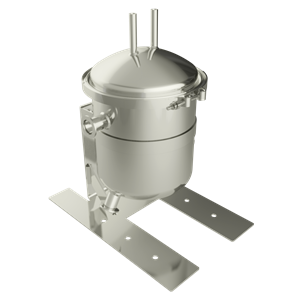
Problems Vapor Condensing Filters Solve
Vapor condensing filters and separators keep harmful vapors from entering equipment and degrading oils or damaging internal components. Under vacuum conditions, some solvents vaporize at relatively low temperatures and require a significant temperature reduction to condense.
The cold temperatures combined with adequate surface area within the vapor condensing housing convert vapors to liquid which can be easily captured and removed before ingestion by the equipment. Removing the vapors can significantly reduce the need for oil changes and repairs.
Common Applications for Vapor Condensing Filters
Vapor Condensing Filters are commonly used in the following applications:
| Chemical and Petrochemical Production |
Solar Energy |
Vacuum Trucks |
| Transformer Manufacturing |
Essential Oils |
Oil Flooded and Dry Vacuum Pump |
| Resin Impregnation and Coating |
Solar Cell Lamination |
Lithium-Ion Battery Manufacturing |
4. Oil Mist Exhaust Filters
What is an Oil Mist Exhaust Filter?
Oil-sealed vacuum pumps will discharge an air and oil mist mixture when they operate. Oil mist exhaust filters also called oil mist filters, oil mist eliminators, or oil mist separators capture these aerosols, coalesce the mist into larger droplets so the oil can be reused in the lubrication system.
Problems Oil Mist Exhaust Filters Solve
Oil mist filters capture discharged vacuum pump oils and minimize waste by allowing users to reuse the collected oils. The air/oil discharge is sometimes referred to as “smoke” due to its white or grey cloud-like appearance when leaving the vacuum pump. 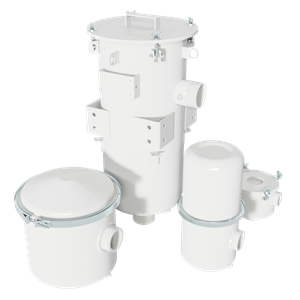
Oil mist eliminator filters also help maintain clean and safe work environments. Keeping oil from discharging to the work area minimizes the potential for oil to accumulate on floors and equipment surfaces.
In some circumstances, oil mist filters also help with odor removal. For heavy odor applications, specialized carbon filters are added after the coalescing air/oil separators to capture residual vapors that cause odors.
Common Applications for Oil Mist Filters
Oil Mist Filters are frequently used in the following application:
| Oil Lubricated Vacuum Pumps |
Blow Exhaust Systems |
Food Processing and Pressure Systems |
| Paper Processing |
Vacuum Coating, Freeze-Dry, and Outgassing
|
Hydraulic Breathers |
| Refrigeration and AC Evaluation Services |
Semiconductors |
Laboratories |
| Autoclaving |
Sterilization |
Electronic Tube and Light Bulb Evacuation |
| Medical Vacuum Systems |
Dental Vacuum Systems |
Power Generation |
| Food and Agriculture |
Chemical and Petrochemical Production |
Pulp and Paper Manufacturing |
| Plastic Forming and Extrusion |
Commercial Printing |
Electronics |
| Glass Manufacturing |
Glass Bottle Manufacturing |
Laboratory and Testing Facilities |
| Marine and Boat Work |
Oil Flooded Vacuum Pump |
|
5. Chemical Adsorption Filters
What are Chemical Adsorption Filters?
Chemical adsorption filters can capture specific vapors and trace amounts of mist present in the airstream. Specialty media such as activated carbon, activated alumina, and molecular sieve are common adsorption media used.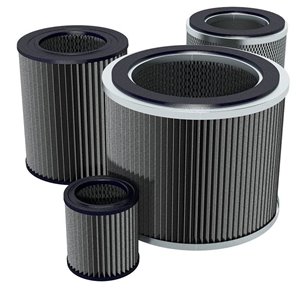
Problems Chemical Adsorption Filters Solve
Chemical adsorption filters are designed to collect volatile organic compounds (VOCs) and other vapors or mist on both the inlet and discharge sides of vacuum pumps. These filters can be useful for capturing residual vapors from a process and can offer odor control benefits as a polishing filter when placed after an oil mist coalescing filter.
Common Applications for Chemical Adsorption Filters
Chemical adsorption filters are commonly used in the following applications:
| Food and Agriculture Processing |
Chemical and Petrochemical Production |
Plastic Forming and Extrusion |
| Wastewater |
Tank and Reservoir Breathers and Vents |
Pneumatic Conveying Systems |
| CNC Hold Down and Router Table |
Glass Manufacturing |
Vacuum Trucks |
| Transformer Manufacturing |
Essential Oils |
Fuel Cell |
| Laboratory and Testing Facilities |
Marine and Boat Work |
Oil Flooded and Dry Vacuum Pump |
| Resin Degassing |
Resin Impregnation and Coating |
Vacuum Drying |
6. Medical Vacuum Filters
What are Medical Vacuum Filters?
Medical vacuum bacterial filters are designed for deployment in medical, dental, and laboratory environments. Bacterial contaminants can be extremely small, so these bacterial filters are designed to filter out particles as small as 0.122 microns in size. These filters are used with vacuum services with pleated filter designs to increase the element surface area. 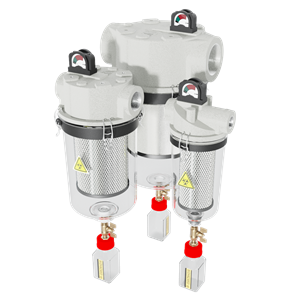
Problems Medical Vacuum Filters Solve
Medical vacuum applications have demanding filtration specifications as outlined in standards including ISO 7396-1:2016, NFPA 99:2018, and HTM 2022. The standards often specify HEPA and even ULPA level filtration and must meet H14 or ISO 45H efficiency requirements. Medical vacuum bacterial filters are designed to meet the strict requirements of medical, dental, and laboratory filtration standards.
Common Applications for Medical Vacuum Filters
Bacterial filters are frequently used in medical and scientific applications, such as:
| Medical Vacuum Systems |
Medical Gas Distribution Systems |
Laboratory and Testing Facilities |
| Dental Vacuum Systems |
Positive Displacement Blowers and Regen Blower |
Oil Flooded and Dry Vacuum Pump |
7. Hydraulic and Gearbox Breathers
What is a Hydraulic Breather Filter?
Hydraulic breather filters (also referred to as gearbox breathers) offer bidirectional venting to filter contaminants such as dust out of the air before they can enter hydraulic tanks. These breathers can also prevent hydraulic fluids and mist from exiting the hydraulic reservoir or gearbox.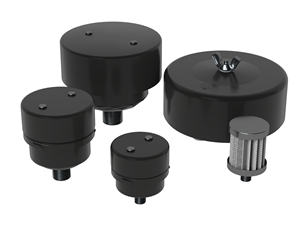
Problems Hydraulic Filters Solve
Hydraulic and gearbox breathers protect hydraulic fluids and lubricating oils from harsh environments where dust and other contaminants can degrade the fluids. Breathers are installed on hydraulic tanks, lube oil reservoirs, and gearboxes in a variety of industries ranging from manufacturing to power generation. Breather filters can also reduce the noise created when air is moving in and out of the tank, reservoir, or gearbox.
Common Applications for Hydraulic Breather Filters
Hydraulic Breathers and Gearbox Breathers are commonly used in the following applications:
| Steel Mills |
Pulp and Paper Processing |
Construction Equipment |
| Power Generation |
Gearbox, Coupling Guard and Bearing Vents |
Tank and Reservoir Breather and Vents |
| Marine and Workboat |
|
|
8. Crankcase Ventilation Systems
What is a Crankcase Ventilation System (CCV)?
Crankcase ventilation systems or CCV filters are air/oil separators that help to prevent hazardous oil mist emissions caused by blow-by from escaping the engine's crankcase. Some crankcase ventilation systems will also regulate crankcase pressure when connected to a vacuum source and equipped with a regulation valve.
Problems Crankcase Ventilation Systems Solve
Crankcase ventilation filters will remove oil mist from blow-by and contain the coalesced oil for reuse or disposal. In closed crankcase scenarios, crankcase ventilation filters protect engine components including turbos and intercoolers from blow-by emissions and oil mist. Excessive blow-by emissions can build up in the working components leading to reduced efficiencies and ultimately, mechanical breakdown of the engine components.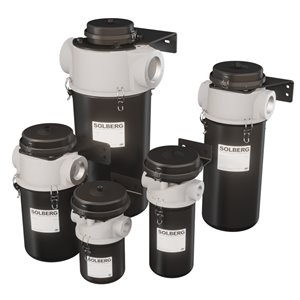
In open crankcase scenarios, oil mist emissions are kept out of engine rooms, or if vented outside, off of walls and other surfaces where condensed oil can accumulate. In both situations, a crankcase ventilation system can be connected to a vacuum source such as the engine turbo or an external blower. A vacuum is used to prevent severe overpressure in the crankcase that can cause seal leakage.
Common Applications for Crankcase Ventilation Systems
Crankcase ventilation filters are used in engines and generator systems, such as:
| Prime Power Engines |
Standby and Emergency Generator Sets |
Marine Propulsion Engines and Generator Sets |
| Natural Gas and Diesel Engines |
Dual Fuel Engines |
Biogas/Digester Gas Engines |
| CHP Applications |
Syngas Engines |
|
Many filter systems will come with specific featured parts. Some may be added as a customizable solution while others will come standard, depending on the application.
9. Multistage Liquid Separator Knock Out Tanks
What is a Liquid Separator?
Liquid separators, often referred to as liquid removal systems or liquid knockout tanks are placed inline before a vacuum pump. They are designed to capture liquids migrating from a process or condensing in vacuum system piping before they can enter the pump. These liquid removal systems use multiple stages including baffles and dropout sections. Demister pads and particulate filters can be added to remove other contaminants present in the process air stream.
Problems Liquid Separators Solve
Liquid knockout tanks separate and collect liquids from process gas streams to protect vacuum pumps from harmful contaminants. Liquid removal filters and separators capture and collect liquids present in the air stream. Water, solvents, oils, cutting fluids, and slurries can degrade vacuum pump oils and cause damage to internal components if ingested.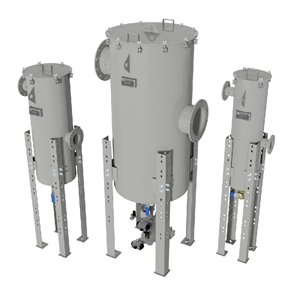
These liquid removal systems have a significant holding capacity and can be fitted with automatic draining systems. Auto drain systems minimize process interruptions and offer an added level of protection should the process contain large volumes of liquid.
Common Applications for Liquid Separators
Knockout tank systems are used to prevent unwanted liquid and moisture contamination for vacuum systems in applications such as:
| Remediation Systems |
Landfill Processing Equipment |
Power Generation |
| Biodiesel |
Food and Agriculture Processing |
Meat Processing |
| Chemical and Petrochemical Production |
Pulp and Paper Processing |
Plastic Forming and Extrusion |
| CNC Hold Down and Router Table |
Glass Manufacturing |
Glass Bottle Manufacturing |
| Vacuum Trucks |
Transformer Manufacturing |
Laboratory and Testing Facilities |
| Positive Displacement and Regen Blower |
Oil Flooded and Dry Vacuum Pump |
|
10. Coalescing Filter Elements
What is a Coalescing Filter Element?
Coalescing filter elements are specialty filters used to capture oil mists in compressed air, vacuum discharge, crankcase ventilation, and other applications where equipment generates mist that must be removed from an airstream. These elements are used primarily for air/oil separation but can also capture other liquid mists such as water, solvents, and other compounds.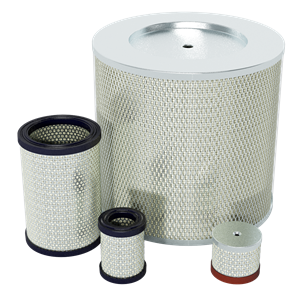
These filters collect coalesced oil, water droplets, and other contaminants with specialty media designed to capture the fine aerosols. The small mist particles coalesce into larger droplets that gravity drags through the different layers of media.
Problems Coalescing Filter Elements Solve?
Coalescing filter elements act as air/oil separators and remove submicron oil mist particles from air streams, keeping oil mist from discharging to the work environment. These coalescing filter elements keep oil mist from contaminating processes or finished goods in compressed air applications.
Common Applications for Coalescing Filter Elements
Coalescing elements are often used with filters in the following applications:
| Compressed Air Filtration Systems |
Refrigeration Systems |
Compressed Natural Gas Filtration |
| Air and Oil Separation |
Food Processing Pressure |
Vacuum Coating |
| Oil Removal for Pressure Unloading Vents on Piston Compressors |
Pulp and Paper Processing |
Medical Applications |
| Dental Applications |
Power Generation |
Biodiesel |
| Food and Agriculture Processing |
Chemical and Petrochemical Production |
Plastic Forming and Extrusion |
| Commercial Printing |
Electronics |
Glass Manufacturing |
| Laboratory and Testing Facilities |
Marine and Workboat |
Oil Lubricated Vacuum Pump |
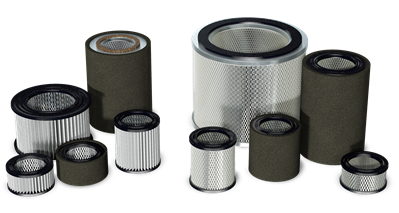
11. Replaceable Filter Elements
What is a Replaceable Filter Element?
Replaceable filter elements, sometimes called filter cartridges, can be inserted into filter housings or canisters, and allow for quick and easy serviceability for a filtration system. Filter elements are constructed of different filtration media depending on the type of contaminants being removed. Filters elements will clog over time and become less effective as particulates collect on or within the media.
There are various designs and materials used for filter cartridges, depending on the application and removal efficiency rating. Some of the most common media are polyester and paper. Filter elements and cartridges can be wrapped for depth filtration or pleated to maximize surface area for surface filtration.
When secured in the filter housing, filter elements must have airtight seals on the open ends to direct the airflow through the filter media. Elements may have a soft molded end cap, hardened end cap configuration with gasket, or a combination depending on the filter housing.
Problems Replaceable Filter Elements Solve?
Filter elements are designed to offer versatility and simplify maintenance for a filtration system. They come in a wide variety of media options, styles, and sizes to meet specific application requirements.
Common Applications for Replaceable Filter Elements
Filter cartridges can be made for virtually any industrial filtration application, and are commonly utilized in:
| Power Generation |
Biodiesel |
Food and Agriculture Processing |
| Chemical and Petrochemical Production |
Pulp and Paper Processing |
Plastic Forming and Extrusion |
| Commercial Printing |
Electronics |
Wastewater |
| Tank and Reservoir Breather and Vents |
Solar |
Pneumatic Conveying Systems |
| CNC Hold Down and Router Table |
Glass Manufacturing |
Vacuum Trucks |
| Transformer Manufacturing |
Essential Oils |
Metallurgy and Vacuum Furnace |
| Fuel Cell |
Laboratory and Testing Facilities |
Marine and Workboat |
| Compressor Inlet |
Positive Displacement and Regen Blower |
Oil Flooded and Dry Vacuum Pump |
| Radical and Centrifugal Fan |
|
|
Conclusion
Industrial filtration is crucial for efficient and effective operations in numerous industries. When selecting and sizing industrial filters and elements, it is important to understand how all of the variables and complexities interact to determine which designs are appropriate for a specific application. Enlisting filtration experts to assist in the selection process can help ensure a successful filtration installation.
If you are interested in partnering with an industrial filtration provider, reach out to Solberg Filtration. We are the leading manufacturer of vacuum filters, compressors, blowers, and oil mist eliminators along with many more industrial filtration products. We also provide customizable solutions for filter sizing and unique applications.
Learn more about our products and services by contacting our team and filling out a quick online form to get started.